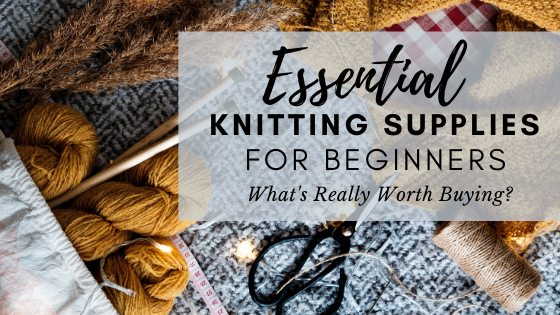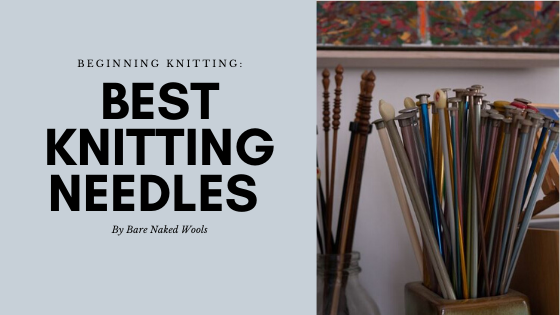Knitting Supplies for Beginners
Knitting is a brilliant hobby offering relaxation, the chance to make beautiful garments, and the opportunity to join a readymade community of supportive knitter friends. It can also be a bit daunting. Especially when you see all the various knitting tools and accessories available online or at your local craft and yarn stores.
How do you know what to buy, so you have the best knitting experience and don't waste money on gadgets and gizmos you'll never use?
It definitely doesn’t need to be overwhelming. Resist the urge to buy everything at once. You only need a few supplies to get started, and we’ve gathered them into a simple list for you, separated by what supplies are essential to have and what's nice to have. (Note: you won’t need to buy everything on this list immediately. Start with the essentials and add to your collection as you go.)
Let's have a look at the best knitting supplies for beginners!
The Essential Supplies
These are only two supplies you can’t do without...but they have a whole lot of options!
Knitting Needles
Needles come in a range of sizes, materials, and even types of needle. Double-pointed (dpns), circular, interchangeable and straight are some of your options.
Don't feel you need to buy needles in every size upfront, building a collection as you go is just fine. That way, you know the type of projects you enjoy knitting and what needles would be most suited. For example, if knitting socks or lace turns out to be your passion, you'll want a collection of smaller needles. At the same time, you don’t want to buy a range of needle sizes for knitting delicate lace if you find you prefer working with bulky yarn.
Buying needles as you go, also give you a chance to try out different materials as you go. For example, some knitters prefer bamboo needles and while others prefer metal, like Chiaogoo Red Lace needles made from stainless steel.
Because there are so many needle options that can make or break your love of knitting, we wrote a more comprehensive guide to choosing knitting needles here.
Yarn
The huge array of yarn types is one of the beautiful attractions of knitting. It comes in such a variety of fibers, colors, textures, weights... and quality.
Our advice? Ignore the siren call of bargain yarn. It's not your only option as a beginner.
You'll have a more enjoyable experience using a yarn you enjoy working with. For example, a natural luxury blend like Better Breakfast DK feels wonderful to work with. It also gives great stitch definition–handy when you’re learning to recognize stitches! (And if you're making something to wear in public, you'll have a beautiful finished project you'll love for years...instead of a future thrift store find).
Beyond the popular DK choices, try a worsted yarn. Both of these yarn weights are thick enough in diameter for easy handling without being so bulky that "normal" yarn will feel like a transition. Projects in worsted knit up quickly, giving you a great feeling of satisfaction. Whatever you choose, lighter shades make it easier to see your stitches as you’re learning.
Try to avoid the novelty yarns (fluffy, sequined, faux fur etc.) until you feel more confident. They can be tricky (or downright frustrating) even for experienced knitters, and you don’t want to put yourself off when you're just getting started.
The (Really) 'Nice to Have' Supplies
These knitting supplies for beginners are exactly that–they’re ‘nice to have’, but you might add them to your collection over time. Where possible, we’ve included DIY options so you can try them out before you invest in them.
Scissors
You’ll need something to snip off your yarn when you’ve finished knitting. You don’t need anything fancy, and technically, you could get away with a sharp kitchen knife...but sewing or embroidery scissors are a great option. They’re small enough to keep in your project bag, so they won’t get used for other household tasks. If you feel like treating yourself, check out a few of the decorative options on Etsy, we love these adorable bestsellers.
Yarn Needle
You’ll need a yarn needle to weave your loose ends back into your work and to sew garment pieces together. Dedicated yarn needles are blunt so they won’t damage your knitting. They also have a big eye to make them easier to thread.
Buy a pack that includes a container so you have somewhere to store your needles. You can pick up a pack for as little as $2.99 on Amazon.
Stitch Markers
You might not need stitch markers often as a beginner, but they’re great to add to your collection when you start more challenging patterns.
They mark where you need to do something specific on a row, like increase a stitch or start a border. Or use them to save having to count hundreds of stitches across a row in a larger project.
These knitting accessories come in a huge range of sizes and styles, from simple rubber rings to fun novelty options.
DIY options include using paperclips or tying a bit of contrasting yarn around the stitch being marked.
Pins
Once you move on to knitting garments, you’ll knit pieces you need to sew together. It’s much easier to sew your seams if you’ve pinned the pieces together first.
You’ll also use pins if you block your knitting, which helps pieces keep their shape. Choose pins with larger heads (like these ‘T’ pins) to make them easier to remove when you’re finished.
Stitch Holders
As you advance, you’ll come across patterns that ask you to ‘hold’ stitches. This means sliding them off the needle and keeping them to one side while you work other stitches.
It’s common when you knit sweaters. You’ll put the center stitches onto a holder while you knit the shoulders. Then you’ll knit the ‘held’ stitches last.
Stitch holders give you somewhere to put these stitches. Slide them onto the holder and click it closed. They come in both metal and plastic. (You might find the metal options more hard-wearing.)
A Light
Depending on where you do your knitting, you might need to buy a light. This helps you to see what you’re working on–handy if you’re knitting with darker colors or knit late at night.
Don’t feel you need to spend a lot on a light. IKEA sell adjustable clamp LED lights for a few dollars that work just as well as special craft lamps.
Crochet Hook
What? Why would you need a crochet hook for knitting? I promise you that we didn't get our hobbies confused. Crochet hooks are used for a few popular cast-ons and bind offs. Crochet hooks also come in incredibly handy for fixing a dropped stitch (trust us, it will happen). You'll want to go a little smaller than the knitting needles you're using. A set of 5 or so can be picked up very inexpensively at any big box craft supply.
Tape Measure
Tape measures come in handy at different stages of knitting. Take your own measurements before you begin a project, so you knit the correct size.
Use a tape measure to check your tension squares before you start a project. Measure projects in progress, such as the back of a sweater before you begin an armhole.
Or use your tape measure while blocking your work when you’ve finished knitting. This will make sure the pieces end up the correct size.
Row Counters
Row counters are extremely helpful because they keep track of where you’re up to in your pattern.
Some row counters slide onto the end of your needle. Twist the counter to add another row each time you finish knitting it!
Prefer digital? There are some handy apps for your devices, both Knit Companion and Row Counter are popular choices among the Knit Community. The advantage of smartphone row counters is you can keep track of rows on several projects and they usually let you import patterns from a variety of sources, including your Ravelry library.
Of course, a pen and paper will do just fine until you find the counter you like best.
Project Bag
It’s a good idea to keep everything you need for a project together. That way, you can pick up your project bag on the way out of the door and dive into your knitting on the go! Keeping your project in its own bag will also stop your work from getting tangled up in your regular bag.
Project bags come in a range of sizes. A nice affordable option is our small and large drawstring project bags starting at just $6. Choose the size that suits your project.
Until you have a project bag, you may want to use a plastic storage container that you have around the house or pick one up at the dollar store. Clean, old purses or backpacks that you don't use often can also be a handy substitute. (Your needles will poke through most grocery bags and baskets may snag your work)
Yarn Bowl
Yarn bowls are a way to hold your yarn while you knit so it doesn’t roll around. Pop the ball in the bowl, thread the yarn through the hole in the side and start knitting.
You can buy beautiful handcrafted ceramic versions online and at craft fairs. Or, if the ball is small enough, use a clean plastic cold drinks cup from your favorite coffee store. Run your yarn through the hole for the straw.
What Knitting Supplies Are On Your "Must-Have" List?
As you can see, it would be easy to overspend on your new hobby at the craft store. Make your life less stressful by starting with the supplies you need for your first project. Add the others as you go, or try out the DIY options, like the homemade yarn bowl from a Frappuccino cup!
Which knitting accessories and tools will you buy first?



![Surprise Knitting Patterns [at a Discount!]](http://www.barenakedwools.com/cdn/shop/articles/blog_KPOW_1.png?v=1585329871&width=600)